
Browse an alphabetical list of film clips that feature important events before, during, and after the Holocaust and World War II. These clips include home movies, propaganda films, newsreels, and more.
<< Previous | Displaying results 101-150 of 191 for "Film" | Next >>
After British soldiers liberated the Bergen-Belsen concentration camp in Germany, they forced the remaining SS guards to help bury the dead. Here, survivors of the camp taunt their former tormentors, who prepare to bury victims in a mass grave.
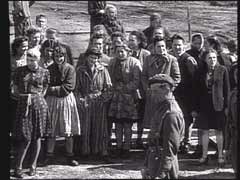
The US army filmed the weak and emaciated survivors of the Buchenwald concentration camp in Germany to document Nazi crimes against humanity. This film was shot shortly after the liberation of the camp in April 1945.
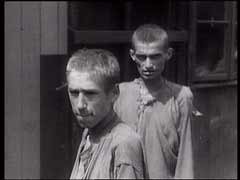
The Dachau concentration camp, northwest of Munich, Germany, was the first regular concentration camp the Nazis established in 1933. About twelve years later, on April 29, 1945, US armed forces liberated the camp. There were about 30,000 starving prisoners in the camp at the time. Here, soldiers of the US Seventh Army document conditions in the camp. They also require German civilians to tour the camp and confront Nazi atrocities.
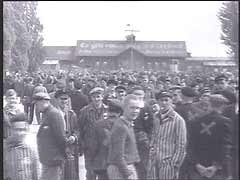
US forces liberated the Dora-Mittelbau (Nordhausen) concentration camp in April 1945. Here, medics and soldiers of the US 3rd Armored Division evacuate sick and dying survivors of the camp.
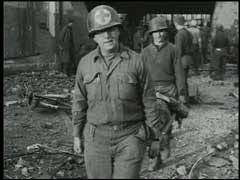
US forces under the command of General Omar Bradley reached the Ebensee forced-labor camp in Austria in early May 1945. The Germans had built Ebensee at the foot of the Austrian Alps as part of the Mauthausen system of camps. The Nazis employed Ebensee prisoners as forced laborers during the construction of an underground rocket factory. Thousands died from the harsh conditions and back-breaking labor.
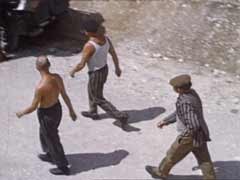
In July 1944, Soviet forces liberated the Majdanek extermination camp. The Polish-Soviet Nazi Crimes Investigation Commission, established to document Nazi atrocities committed during the German occupation of Poland, ordered exhumations at Majdanek as part of its efforts to investigate Nazi mass killings in the camp. The commission later published its findings in Moscow on September 16, 1944, in Polish, Russian, English, and French.
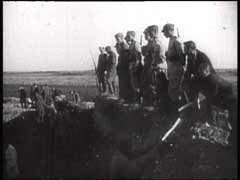
The Mauthausen concentration camp was established shortly after the German annexation of Austria (1938). Prisoners in the camp were forced to perform crushing labor in a nearby stone quarry and, later, to construct subterranean tunnels for rocket assembly factories. US forces liberated the camp in May 1945. In this footage, starving survivors of the Mauthausen concentration camp eat soup and scramble for potatoes.
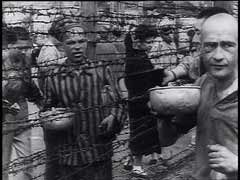
This film footage is excerpted from documentary film titled "Mauthausen Concentration Camp," showing footage from both Mauthausen and the nearby Gusen camp. Filmed by US cameramen, the footage opens with a broad view of buildings in the Gusen camp. Excerpts that follow show scenes in the camps, American care of the liberated prisoners, and Austrian civilians loading bodies of victims onto carts for burial.
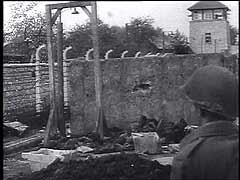
General Dwight D. Eisenhower and other American officers inspect conditions in the Ohrdruf concentration camp shortly after the liberation of the camp. As American forces had approached, SS camp guards shot the remaining prisoners before abandoning the camp. Confirmation of such atrocities prompted the US military to require Nazis and local German civilians to view the camps.
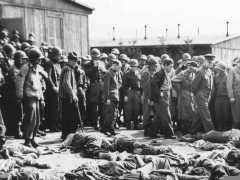
After Italy's armistice with the Allies in September 1943, the Italian army disintegrated. The country was divided between German forces holding the northern and central regions (including Rome) and Allied forces in the south. After nine months of bitter combat, Allied forces—specifically the US Fifth Army—liberated Rome in June 1944. This footage shows scenes of celebration as troops move through Rome. It ends with a prayer by Pius XII (pope, 1939–1958).
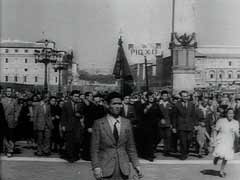
The German army occupied Lodz, Poland, in September 1939. From early February 1940, Jews in Lodz were forced to move to a designated ghetto area, which was sealed on April 30, 1940. This German footage illustrates conditions during winter in the Lodz ghetto. Winter in the ghettos aggravated existing hardships, depleting already sparse supplies of food and fuel.
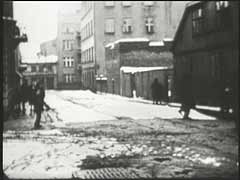
The Medical Case was one of 12 war crimes trials held before an American tribunal as part of the Subsequent Nuremberg Proceedings. The trial dealt with doctors and nurses who had participated in the killing of physically and mentally impaired Germans and who had performed medical experiments on people imprisoned in concentration camps. Here, chief prosecutor Brigadier General Telford Taylor reads into evidence a July 1942 report detailing Nazi high-altitude experiments and outlines the prosecution's goals…
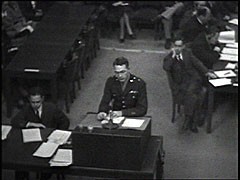
After word reached America of the Nazi killing of European Jewry, pressure mounted on the Roosevelt administration to help European Jews. To spur action, playwright Ben Hecht prepared a memorial to the Jewish victims of Nazi persecution, "We Will Never Die." The pageant, sponsored by the Zionist Revisionist Bergson Group, was part of a mass demonstration at Madison Square Garden in New York City. Later seen in other US cities, the show was part of the Bergson Group's effort to pressure Washington to act…
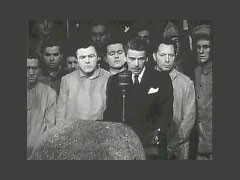
The German army occupied Krakow, Poland, in September 1939. In March 1941, the Germans ordered the establishment of a ghetto in Krakow. In this footage, Polish Jews are forced to move into the Krakow ghetto. They wear the required armbands, used to distinguish the Jewish population from the rest of the city's residents. By late 1941, there were some 18,000 Jews imprisoned in the Krakow ghetto.
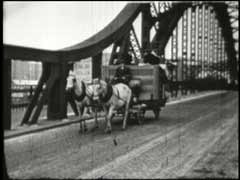
In 1936, Germany and Italy signed a military alliance. The two powers formed the so-called Berlin-Rome Axis. This footage shows Italian Fascist leader Benito Mussolini's state visit to Germany in September 1937. He met with Hitler in Munich and the two leaders also toured other parts of Germany. During the state visit, Mussolini attended a military parade in Berlin, Germany's capital. Although both dictators declared their desire for peace, Germany would begin World War II in 1939. Italy would then enter…
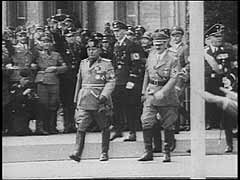
Soon after the Nazis assumed power in Germany, they launched a campaign to deprive Jews of their place in society. The effort began with an organized boycott of Jewish-owned businesses. Gangs arrested Jews, painted "Jews forbidden" onto shop windows, chanted antisemitic slogans, and blocked store entrances.
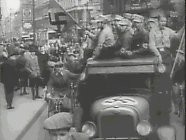
US forces liberated the Buchenwald concentration camp on April 11, 1945. This footage records examples of Nazi atrocities (shrunken head, pieces of tattooed human skin, preserved skull and organs) discovered by the liberating troops.
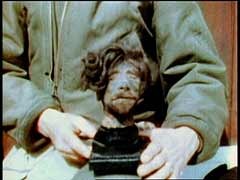
In the 1920s and 1930s, the German city of Nuremberg was host to massive and lavish rallies for the Nazi Party. This film footage, produced by Julien Bryan in 1937, shows saluting crowds in the Nuremberg stadium watching groups parade past Adolf Hitler.
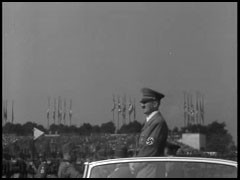
Hitler congratulates industrialist Gustav Krupp after presenting him with a Nazi party honor. After the ceremony, they toured a Krupp factory. This footage comes from the film "The Nazi Plan," produced and used by the United States in the prosecution at the Nuremberg trials.
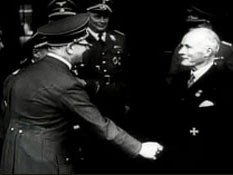
Clip from George Stevens' "The Nazi Concentration Camps." This German film footage was compiled as evidence and used by the prosecution at the Nuremberg trials.
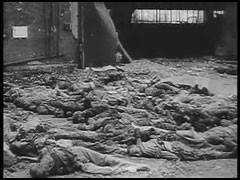
This German newsreel footage shows Vidkun Quisling, leader of the fascist Norwegian Nasjonal Samling party, reviewing his troops. Quisling headed a pro-Nazi puppet regime in Norway during the war.
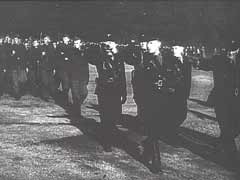
This footage comes from "Nuremberg, Its Lesson for Today" a 1947 documentary film produced by the US military's Documentary Film Unit, Information Services Division. The film, directed by Pare Lorentz and Stuart Schulberg, shows footage from the trial of Nazi war criminals by the International Military Tribunal. It also intermixes historical footage depicting the founding of the Nazi state, the unleashing of World War II, and Nazi crimes against humanity. The sentencing sequence shown here illustrates the…

Hermann Göring recites the preamble to the Nuremberg Laws at the seventh Nazi Party Congress. The laws would define German citizenship by blood and forbade marriages between Germans and Jews. A special session of the Reichstag (German parliament) enacted the laws, marking an intensification of Nazi measures against Jews.
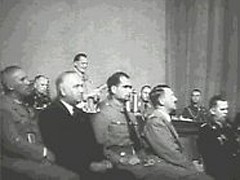
Hermann Göring was head of the German air force. He was one of 22 major war criminals tried by the International Military Tribunal at Nuremberg. Here, Göring testifies about his order of July 31, 1941, authorizing Reinhard Heydrich, head of the Reich Security Main Office, to plan a so-called "solution to the Jewish question in Europe." The Tribunal found Göring guilty on all counts and sentenced him to death. Göring committed suicide shortly before his execution was to take place.
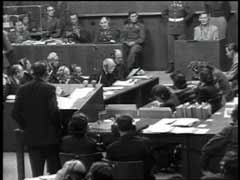
The 1936 Summer Olympic Games were held in Berlin. For two weeks, Adolf Hitler camouflaged his antisemitic and expansionist agenda while hosting the games. Hoping to impress the many foreign visitors who were in Germany for the games, Hitler authorized a brief relaxation in anti-Jewish activities (including the removal of signs barring Jews from public places). The games were a resounding propaganda success for the Nazis. They presented foreign spectators with the image of a peaceful and tolerant Germany.…
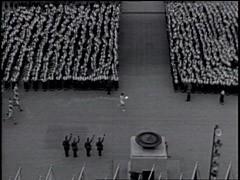
In 1933, Nazi Party leader Adolf Hitler became chancellor of Germany and quickly turned the nation's fragile democracy into a one-party dictatorship. Police rounded up thousands of political opponents, detaining them without trial in concentration camps. The Nazi regime also put into practice racial policies that aimed to "purify" and strengthen the Germanic "Aryan" population. A relentless campaign began to exclude Germany's one-half million Jews from all aspects of German life. For two weeks in August…
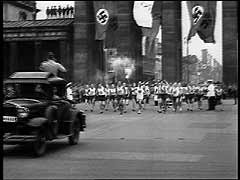
The Storm Troopers (SA) established the Oranienburg camp near Berlin in March 1933. The first prisoners were German political prisoners, primarily Communists and Social Democrats. Oranienburg became known for the maltreatment of inmates. Here, the Nazis attempt to undermine the charges of brutality by showing the "normal" prisoner routine. Oranienburg was gradually deactivated, closing by 1935. Most of the other early camps were also closed, to be replaced with larger camps run by the SS.
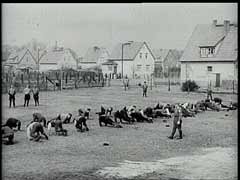
The Soviet Union occupied Lvov in September 1939, according to secret provisions of the German-Soviet Pact. Germany invaded the Soviet Union on June 22, 1941, occupying Lvov within a week. The Germans claimed that the city's Jewish population had supported the Soviets. Ukrainian mobs went on a rampage against Jews. They stripped and beat Jewish women and men in the streets of Lvov. Ukrainian partisans supported by German authorities killed about 4,000 Jews in Lvov during this pogrom. US forces discovered…
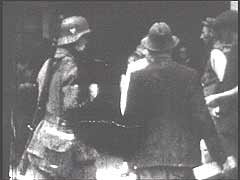
After the sudden death of Franklin D. Roosevelt in April 1945, Vice President Harry S. Truman became president of the United States. Here, President Truman meets with the heads of state of the Soviet Union and Great Britain (Joseph Stalin, Winston S. Churchill, and later Clement Attlee) in Potsdam, near Berlin, to discuss the future of defeated Germany. The leaders agreed to the partition of Germany and Berlin, Germany's capital city, into four zones of occupation: British, French, American, and Soviet.…
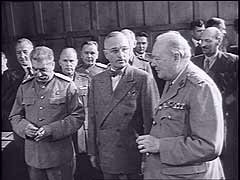
Roma (Gypsies) celebrate with music, dancing, and singing in the mountains near Zagreb, Yugoslavia. During World War II, Roma in Yugoslavia were exterminated by Croatian nationalists and by the Germans.
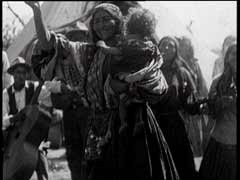
After the Germans established the Warsaw ghetto in 1940, the Jewish council in Warsaw became responsible for the full range of city services inside the ghetto area. In this German footage, prisoners from the ghetto's "Jewish prison" run into the courtyard and walk in circles during inspection.
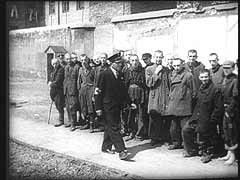
In July 1947, 4,500 Jewish refugees left displaced persons camps in Germany and boarded the "Exodus 1947" in France. They attempted to sail to Palestine without, however, having British permission to land. The British intercepted the ship and forcibly returned the refugees to Germany. This footage shows a protest in the Bergen-Belsen displaced persons camp in the British occupation zone of Germany. The protesters denounced British treatment of the "Exodus 1947" passengers. The plight of the "Exodus"…
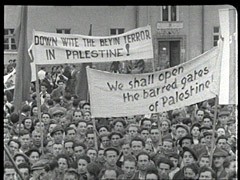
The film "Nazi Concentration Camps" was presented in the courtroom on November 29, 1945, and entered as evidence in the trial. It was filmed as Allied troops liberated the concentration camps. This clip shows the reactions of defendants and others in the courtroom following the screening of the film.
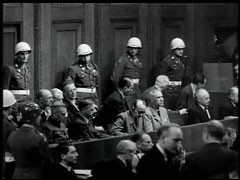
In July 1947, 4,500 Jewish refugees left displaced persons camps in Germany and boarded the "Exodus 1947" in France. They attempted to sail to Palestine although they did not have permission from British authorities to land. The British intercepted the ship and forcibly returned the Jewish refugees to Germany. Here, Jews from the "Exodus 1947" are confined in Poppendorf, Germany. The plight of the "Exodus" passengers became a symbol of the struggle for open Jewish emigration to Palestine.
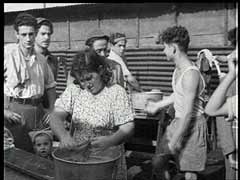
This footage shows the Reichstag (German parliament) building on the day after it was set on fire. While the origins of the fire on February 27 are still unclear, Hitler blamed Communists for the incident. The Reichstag Fire Decree of February 28, 1933, suspended constitutional guarantees. Communist and Socialist deputies were expelled from the parliament. Shortly after the decree was issued, the Nazis established concentration camps for the internment of political opponents.
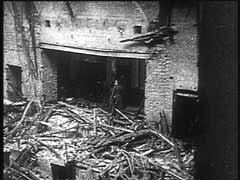
On the night of February 27, 1933, an unemployed Dutch construction worker named Marinus van der Lubbe set fire to the Reichstag (German parliament) building, causing serious damage. The Nazis blamed the Communists for the fire and claimed emergency powers to crush all opposition. Bolstering Nazi claims, the police also arrested three Bulgarian members of the Communist International, who were in Germany at the time, and a leading German Communist. Despite Nazi claims, however, responsibility for the fire…

German forces launched Operation "Barbarossa," the invasion of the Soviet Union, on June 22, 1941. The German army made rapid initial progress in the campaign into Soviet territory. In this German military footage, German soldiers separate women and children from men in a Soviet village.
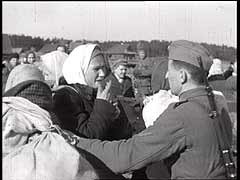
Provisions of the 1919 Treaty of Versailles forbade Germany (defeated in World War I) to station armed forces in a demilitarized zone in the Rhineland—a region in western Germany bordering France, Belgium, and part of the Netherlands. The treaty stipulated that Allied forces—including US troops—would occupy the region. In a blatant violation of the treaty, on March 7, 1936, Hitler ordered German troops to reoccupy the zone. Hitler gambled that the western powers would not intervene. His action…
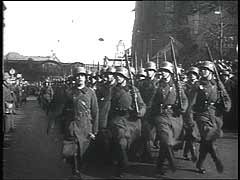
In June 1944, the Soviet Union launched a massive offensive against the German army in eastern Europe. Soviet forces reoccupied Vilna in July 1944, after bitter street fighting with the German garrison. They then continued on toward Kovno, the capital of Lithuania. This Soviet footage depicts the battle for Vilna and the final reoccupation of the city by the Soviet army.

About a million Roma (Gypsies) lived in Europe before World War II. The largest Romani community—of about 300,000—was in Romania. This film shows a Romani (Gypsy) community in Moreni, a small town northwest of Bucharest. Many Roma led a nomadic lifestyle and often worked as small traders, craftsmen, merchants, laborers, and muscians.
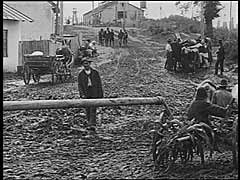
Germany and its Axis allies invaded Yugoslavia in April 1941. The Germans probably shot this film after they occupied southern Slovenia following the Italian armistice in 1943. The film was found in the Ustasa (Croatian fascist) archives after World War II and shows the dismal living conditions that Roma (Gypsies) endured in occupied northern Yugoslavia.
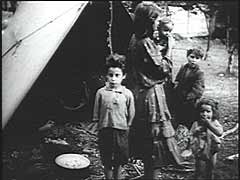
This film excerpt from Groß-Stadt Zigeuner (1932) by filmmaker László Moholy-Nagy shows a Romani (Gypsy) campsite near Berlin, Germany, in the last year of the Weimar Republic. Although Roma (Gypsies) had faced persecution in Germany even before the Nazi rise to power in 1933, the Nazis regarded them as racial enemies to be identified and killed. Tens of thousands of Roma were killed by the Einsatzgruppen in eastern Europe or were deported to killing centers in occupied Poland.
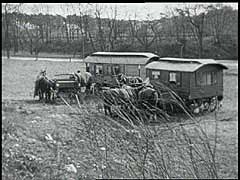
Eva Justin was an assistant to Dr. Robert Ritter, the Third Reich's "expert" on Roma (Gypsies). She studied these Romani (Gypsy) children as part of her dissertation on the racial characteristics of Roma. The children stayed at St. Josefspflege, a Catholic children's home in Mulfingen, Germany. Justin completed her study shortly after this film was taken. The children were deported to Auschwitz-Birkenau, where most were killed.
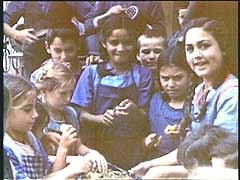
Although constrained by powerful isolationist sentiment in the United States, President Roosevelt was determined to help democratic Great Britain continue the war against Nazi Germany. Even as he promised to keep the United States neutral in the European war, Roosevelt ordered the expansion of military construction and pledged--as shown in this footage--that the United States would serve as the "great arsenal of democracy." In March 1941, Congress approved Lend-Lease aid for Britain. Britain ultimately…
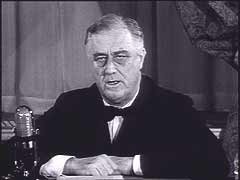
The Buchenwald camp was one of the largest concentration camps. The Nazis built it in 1937 in a wooded area northwest of Weimar in central Germany. US forces liberated the Buchenwald camp on April 11, 1945. When US troops entered the camp, they found more than 20,000 prisoners. This footage shows scenes that US cameramen filmed in the camp, survivors, and the arrival of Red Cross trucks.
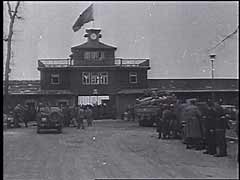
Children from the cheder (traditional religious school) in Munkacs recite their lesson.
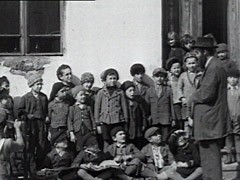
US prosecutor Thomas Dodd introduces the film compilation "Nazi Concentration Camps." At the end of the courtroom scene shown here, the lights are dimmed for the screening. The footage, filmed as Allied troops liberated the concentration camps, was presented in the courtroom on November 29, 1945, and entered as evidence in the trial.
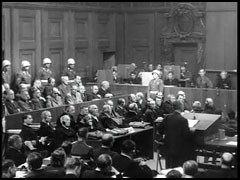

How was the Holocaust possible? The central role of Hitler and other Nazi Party leaders is indisputable. Less well understood is these perpetrators’ dependence on countless others. In countries across Europe, tens of thousands of ordinary people actively collaborated with German perpetrators of the Holocaust. Many more supported or tolerated the crimes. The special exhibition Some Were Neighbors: Collaboration & Complicity in the Holocaust was underwritten in part by grants from The David Berg…
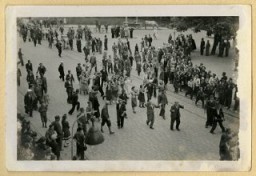
The Germans invaded the Soviet Union in June 1941 (Operation "Barbarossa"). German forces occupied Vitebsk in the northeastern region of Belorussia on July 11. Soviet forces seized the initiative from the Germans after the battle of Stalingrad in late 1942 and early 1943. The Soviet army liberated Vitebsk on June 26, 1944, during their summer 1944 offensive. This footage shows military units involved in the fighting and German soldiers captured during the campaign. By the end of the summer, the Soviet…
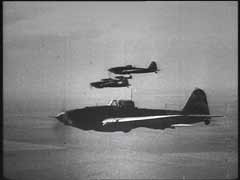
We would like to thank Crown Family Philanthropies, Abe and Ida Cooper Foundation, the Claims Conference, EVZ, and BMF for supporting the ongoing work to create content and resources for the Holocaust Encyclopedia. View the list of donor acknowledgement.